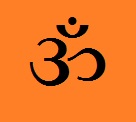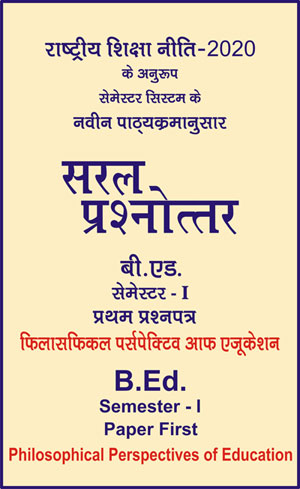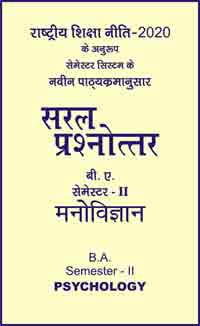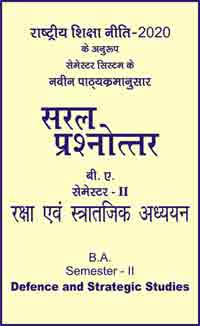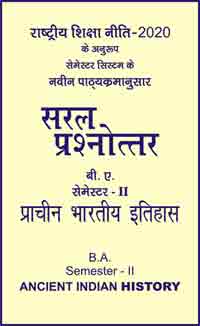|
बी एड - एम एड >> बी.एड. सेमेस्टर-1 प्रश्नपत्र-I - फिलासफिकल पर्सपेक्टिव आफ एजुकेशन बी.एड. सेमेस्टर-1 प्रश्नपत्र-I - फिलासफिकल पर्सपेक्टिव आफ एजुकेशनसरल प्रश्नोत्तर समूह
|
5 पाठक हैं |
|||||||
बी.एड. सेमेस्टर-1 प्रश्नपत्र-I - फिलासफिकल पर्सपेक्टिव आफ एजुकेशन (अंग्रेजी भाषा में)
Question- How can Philosophy be used in the classroom? Also discuss the salient features of knowledge according to Indian Philosophy of education.
Answer -
Philosophy is not a set of written words. It is a platform upon which decisions are made and life is led. A teacher’s practices in the classroom reflect his or her personal philosophy. The best goal for beginning educators is to become comfortable with a variety of classroom practices that address the needs of learners. It is to be noted that a sound preparation for teaching addresses the need to develop a classroom philosophy one that incorporates the larger role of teaching in a complex society as well as the micro role of the teacher working with students in the classroom setting.
Classroom Organization
All teachers must be able to organize the classroom in such a way that it is conducive to teaching and learning. In fact, many School Principals quick to assert that the easiest way to predict the success of a beginning teacher is to evaluate his or her ability to organize the classroom. Actually, classroom organization is a multi-faced dimension of teaching that includes the content, methods, and values that infuse the classroom environment. It is a dimension of teaching that requires analysis and selection similar to that used in the identification of a preferred teaching philosophy.
Lesson Planning
Careful lesson planning is mandatory if effective teaching and learning are to follow. If the learners are considered to be passive, the lesson plan may emphasize students’ absorption of the factual content of the subject matter.
Regardless of the expectation for the learner, active or passive, the teacher needs to plan sound lessons. Every lesson should be built from a basic set of general objectives that correspond to the overall goals of the school district. Daily lesson objectives can vary from classroom to classroom depending on the particular needs of the students being served. However, if those daily teaching objectives are closely related to the overall objectives of the school district, then cross-district learning will reflect the school district’s overall goals.
The Physical Setting
The mere arrangement of classroom furniture and the use of classroom materials may be predicated on the teacher’s perception of the learners as passive or active.
Traditionally, the classroom has tended to be arranged in rows and columns at the elementary and secondary levels of schooling. This type of classroom arrangement has often been thought to be best for classroom control and supervision. The elementary teacher will rearrange the classroom into a series of small circles for special groupings in reading, mathematics, and other specific subjects.
Student Assessment and Evaluation
In assessing student progress and assigning grades, most teachers use a variety of techniques including examinations, term papers, project reports, group discussions, performance assessments, and various other tools. If the subject matter is treated as a bundle of information, teacher-made tests will tend to seek certain facts and concepts as “right” Answer -s, suggesting emphasis on convergent thinking. However, if the subject matter is treated as big ideas applicable to problem solving and if students are expected to engage in processes and develop skills to arrive at several “right” Answer -s, teacher-made tests will tend to allow for divergent thinking.
Salient Features of Knowledge according to Indian
Philosophy of Education
In Indian philosophy of education, Nyaya has specialized in the fields of logic and epistemology. Knowledge has been explained as the manifestation of objects. According to Nyaya, valid knowledge is definite or real, knowledge and it consists in knowing the object as it is, for example, to know the snake as a snake and the bowl as a bowl. Valid knowledge has four distinctive sources viz., perception, inference, comparison and testimony, knowledge arising from sources other than these is called invalid or aprama knowledge.
Whenever there are sufficient conditions for the generation of a particular kind of knowledge, there arises at once that kind of knowledge containing an element of belief in the object known.
For instance, when our normal eyes light on an object conveniently situated in broad daylight, there is visual perception; when he hear some one speak a meaningful sentence, we have knowledge from his testimony. When these are sufficient premises, inference takes place. That we act on such knowledge in daily life as soon as we have it, without any attempt to test its validity by argument, shows that we believe in it as soon as it arises; and the fact that such knowledge leads to successful activity and not to any contradiction shows further that such knowledge is valid. When, however, the conditions required for the generation of that kind of knowledge are known to be defective or wanting, no such knowledge arises; neither, therefore, does any belief arise, so long as the grounds for doubt and disbelief do not disappear. From these facts two conclusions are drawn by the Mimamsa:
(a) The validity of knowledge arises from the very conditions that give rise to that knowledge and not from any extra conditions.
(b) The validity of a knowledge is also believed in or known as soon as the knowledge arises; belief does not await the verification of the knowledge by some other knowledge, say, and inference. This Mimamsa view, in its double aspect, is known as the theory of intrinsic validity.
Truth is self-evident, according to this view, whenever any knowledge arises, it carries with it an assurance about its own truth. Sometimes another knowledge may point out that this assurance is misleading or that the conditions of the knowledge are defective. In such a case we draw inference from the existence of defective conditions the falsity of the knowledge. Thus the falsity of a knowledge is ascertained by inference, while truth is self-evident.
|
|||||




